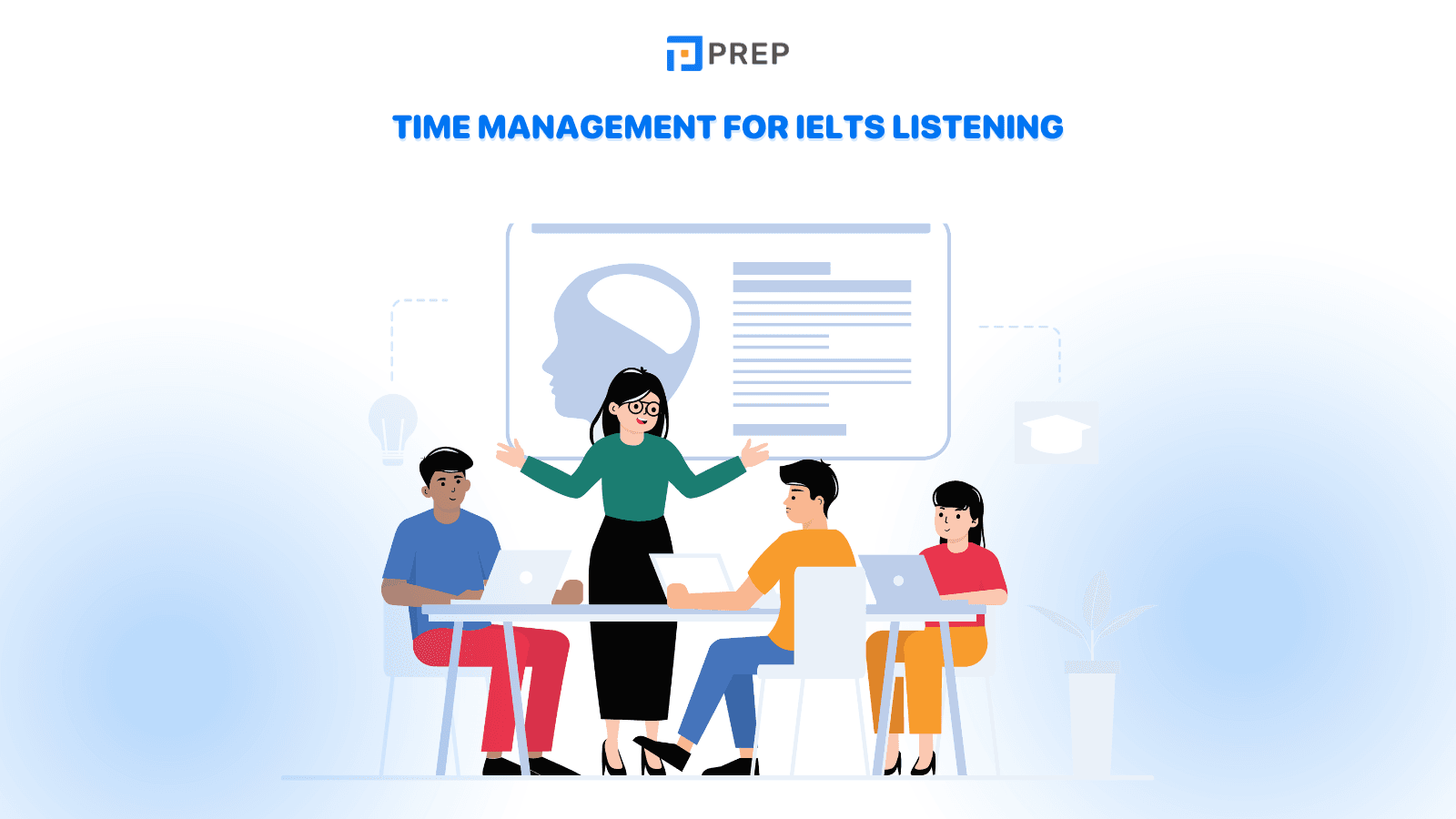How to Master Time Management in IELTS Listening
Time management is a key factor in achieving a high IELTS Listening score. This guide explains how to plan your time for each section, avoid common mistakes, and apply step-by-step strategies effectively. Learn how to stay focused and complete all answers on time in the real test.

I. Why Time Management Matters in IELTS Listening?
The IELTS Listening test may seem straightforward: 40 questions across 4 sections, completed in about 30 minutes. However, many test-takers are surprised to find just how intense that half-hour can feel—especially without effective time management.
Understanding how to manage your time in IELTS Listening isn't just a bonus—it's essential to performing well under pressure. Below are some key timing challenges students often face, and why addressing them early in your practice matters.
The IELTS Listening Structure and Timing
The Listening test includes four recordings, each increasing in complexity:
- Section 1: A conversation in a social context (often phone calls or bookings)
- Section 2: A monologue about a general topic (e.g., a tour or facility description)
- Section 3: A conversation between multiple speakers, often academic
- Section 4: A lecture or academic talk
You’ll have just one chance to hear each recording. While you're listening, you also need to:
- Read the questions ahead
- Identify key words
- Follow instructions
- Write your answers in real time
After the audio finishes, you'll get 10 minutes to transfer your answers to the answer sheet—but all the “real work” happens during those initial 30 minutes.
Without a clear time strategy, it’s easy to fall behind and lose marks—not because of lack of skill, but because of poor pacing.
-
Before diving into strategies, it helps to understand the IELTS Listening test format so you can allocate your time wisely.

Common Time-Related Challenges
- Missing questions entirely because you didn’t read them before the audio began. You may hear the answer but not recognize it because you didn’t know what to listen for.
- Falling behind the flow - If you’re still reading question 17 while the speaker is already giving the answer to 18 or 19, it’s hard to catch up. One missed question can snowball into several.
- Rushing through answer transfer time - If you wait until the very end to fix all your spelling or check your answers, you might not finish in time.
- Test day stress leads to mental fatigue and mistakes - Without confidence in your timing, you may feel overwhelmed, leading to careless errors—even on questions you would normally get right.
These issues are not caused by poor listening skill alone, but by poor attention management, lack of anticipation, and inefficient preparation methods.
II. Step-by-Step Strategies for Better Time Management
Mastering IELTS Listening isn't just about improving your listening skills—it's about learning how to think ahead, stay focused, and make timely decisions during the test. Below are four practical, easy-to-follow steps that will help you manage your time more effectively and avoid losing points unnecessarily.
You can combine these strategies with general IELTS Listening tips for maximum results.

Step 1 – Preview and Predict Before the Audio Starts
At the beginning of each section, you’ll have a short time (about 30–45 seconds) to read through the upcoming questions. This is your most valuable window—use it wisely.
What to do:
- Underline keywords in each question (names, numbers, verbs).
- Try to predict the type of answer expected: a date? a name? a place?
- Take a quick look at multiple questions if time allows—to stay a step ahead during the audio.
By previewing and predicting, you build a mental map to follow along more easily once the recording begins.
Step 2 – Listen Actively, Not Passively
Active listening means you’re fully engaged: reading the questions, listening for answers, and writing them down—all at once. Passive listening (just “hoping to catch the answer”) leads to lost marks.
Key strategies:
- Listen for signpost words (first, however, but, finally)—they help you track structure.
- Expect paraphrasing—don’t wait to hear the exact word in the question.
- Keep your pen moving—but don’t panic if you miss a word. Stay focused on the next one.
Your goal is to match what you hear with what you read in real time. or applied practice, try working through a note completion in IELTS Listening task under timed conditions.
Step 3 – Pace Yourself and Stay in Control
It’s common to lose your place or get stuck on a confusing question. That’s when people fall behind. Keep your test rhythm steady.
How to stay in control:
- If you miss a question, move on immediately—don’t risk missing more.
- Use the short pauses between question groups (e.g., 21–25, 26–30) to re-center.
- Track the audio with your eyes and adjust quickly if the speaker speeds up or changes direction.
Being aware of your place—as a listener and a test-taker—keeps you ahead of timing traps.
Step 4 – Review and Transfer Answers Wisely
At the end of the listening test, you’ll have 10 minutes to transfer your answers to the answer sheet. Many students waste this time or lose marks by transferring answers carelessly.
Here’s what to do:
- Check spelling and grammar carefully, especially with articles ("a"/"an"/"the").
- Make sure all answers are written in the right boxes—small mistakes lead to scoring zero.
- Don’t try to change too many answers unless you're sure—they are often correct as written.
The 10-minute transfer time is not for catching up—it’s for final precision.
With consistent practice using these four steps, managing your time in the IELTS Listening test becomes easier, more predictable, and far less stressful. You can also check out more ways to improve IELTS Listening to complement your timing strategies.
III. Common Time Management Mistakes and How to Avoid Them
Even well-prepared IELTS candidates can lose valuable marks—not because of weak listening skills, but due to avoidable time management errors. Recognizing these common mistakes early on can save you time, stress, and points on test day. Let’s explore the top issues and how to fix them effectively.
|
Mistake |
Description |
How to Avoid It |
|
Not reading the questions before audio |
Entering the listening section without previewing the questions |
Use the 30–45 seconds before each section to scan questions and underline keywords |
|
Losing focus during long sections |
Difficulty staying concentrated in Sections 3 & 4 due to speaker changes or topic shifts |
Train active listening with full-length recordings; listen for signpost words |
|
Spending too much time on one question |
Overthinking a difficult question and missing the next few |
Make a guess if unsure and immediately move on to stay in sync with the audio |
|
Ignoring spelling and grammar issues |
Losing easy points due to avoidable spelling or format errors in transferred answers |
Practice daily spelling (especially dates, numbers), review plural/singular usage |
|
Misusing transfer time |
Treating the 10-minute transfer as a break, not reviewing carefully |
Use transfer time to double-check spelling, grammar, and alignment on the answer sheet |
Avoiding these mistakes requires more than just knowledge—it takes smart practice. By simulating real test conditions and staying aware of these pitfalls, you’ll sharpen both your timing and accuracy.
IV. Time Allocation for Each Section in IELTS Listening
To perform well in the IELTS Listening test, it's not enough to simply listen well—you also need to understand how to pace yourself throughout the test. The Listening test is split into 4 sections, and while the audio flows continuously, each part presents unique challenges that require different time management tactics.
Understanding the overall structure
- Total listening time: approximately 30 minutes
- Number of questions: 40 (10 questions per section)
- Additional time: 10 minutes at the end to transfer answers to the answer sheet
- Key timing note: You only listen to each recording once—there are no repeats.

Section-by-Section Time Management
|
Section |
Features |
Time Challenges |
Time Management Tips |
|
Section 1 |
Conversation in a social setting (e.g., booking, inquiry) |
Simple content but lots of numbers, dates, and short answers all at once |
Use preview time to scan for question types (form/table). Listen carefully for details. |
|
Section 2 |
Monologue in a public context (e.g., tour, instructions) |
Contains maps, matching, or multiple choice; audio can jump between ideas |
Pay attention to order of information and transitions (“next,” “then”) |
|
Section 3 |
Academic conversation between 2–4 speakers |
More speakers = higher risk of confusion about who says what |
Focus on speaker roles. Use tone/keywords to stay aligned with the dialogue |
|
Section 4 |
Academic lecture or talk, only one speaker |
Fastest and longest section—no breaks, more ideas and vocabulary |
High concentration needed. Use prediction + note keywords quickly |
How to stay on pace during the test
- Use the few seconds before each set of questions to read ahead and predict.
- Never dwell on a missed question—refocus on the current one to avoid snowballing errors.
- Use tone and structure in speech ("Let’s begin with...", "Another point is...") as signals to shift attention.
- Keep a steady rhythm: stay engaged, alert, and mentally one step ahead.
Developing an intuitive sense of how each section is structured—and where you're most likely to lose time—can help you avoid the most common mistakes and use your time more effectively. With consistent practice under timed conditions, this time awareness becomes second nature.
This article has provided some tips and strategies for time management for IELTS Listening. PREP wishes you effective self-study and success in achieving your desired score!

Hi I'm Chloe, and I am currently serving as an Product Content Administrator at Prep Education. With over five years of experience in independent online IELTS study and exam preparation, I am confident in my ability to support learners in achieving their highest possible scores.
Comment
Premium content
View allPersonalized roadmap
Most read












